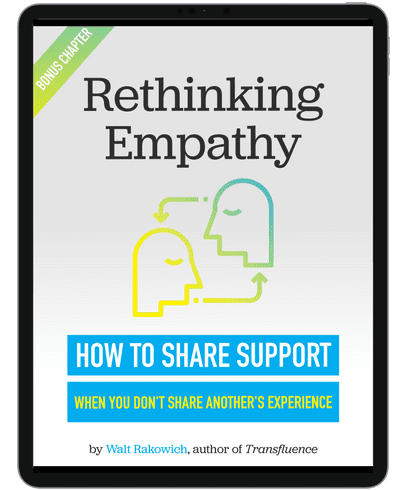An excerpt from Rethinking Empathy: How to Share Support When You Don’t Share Another’s Experience, a bonus chapter to Transfluence.
The everyday emotional needs of people in the workforce have always challenged leaders. And the complexities of those challenges have only increased in recent years. The dynamic marketplace environment is more diverse, moves faster, and provides more access to people and data than ever. But two realities emerged in 2020 that accentuated the emotional stresses we all face. One was the impact of the global pandemic on our mindsets and ways of doing life; the other was the boiling over of social discord on issues related primarily to race and politics.
The pandemic created a globally shared experience unlike anything since World War II. We all found ourselves in the same storm, but each of us weathered the waves in our own boat. Everyone could relate to the inconvenience of wearing a mask in public, for instance, but levels of stress and anxiety varied wildly. An ER nurse in the Bronx experienced the pandemic quite differently than a rancher in Montana (or even a co-worker in the same hospital). But a majority had this in common: The challenges of the pandemic were mentally and emotionally draining.
A Harvard Business Review report early in 2021 declared that, “The pandemic has led to mental health declines, increased work demands, and feelings of loneliness.” The researchers surveyed around 1,500 people from 46 countries, of which 85% reported a decline in their general well-being and 89% reported a decline in their workplace well-being.
The causes varied greatly but included such themes as general mental health decline, increased stress and anxiety, increased job demands, loss of connections, struggles with home-life balance, challenges with new technologies, employment changes, job security concerns, and a feeling of lack of support from leaders.
How to Share Support When You Don’t Share Another’s Experience
If you’d like to explore more about empathy and how to improve your leadership empathy skills, download my new bonus chapter.

In the first half of 2019, an average of 11% of US adults reported some symptoms of anxiety or depressive disorders, according to a report by the Kaiser Family Foundation (KFF). In January 2021, it was a whopping 41.1%.
In addition to the pandemic, much of the world — and especially the US — has become emotionally divided over political and social issues. The most obvious examples, of course, are the protests and riots after the death of George Floyd in May 2020 and the storming of the US Capitol in early 2021 by a mob upset about the presidential election results.
Most business leaders don’t have to deal with the more radical fringes of society, but many employees relate to and sympathize with a variety of viewpoints on all sorts of hot-button issues. Many say they feel marginalized, unheard, or cancelled. And while those feelings typically don’t result in violence, a deeper and far more common issue is the rude or unsociable behavior that’s best summed up as incivility.
Weber Shandwick and Powell Tate, in partnership with KRC Research, have done an annual survey on civil discourse since 2010, and it consistently finds that more than 95% of Americans say incivility is a problem and 65-68% classify it as a major problem. And Christine Porath, a professor in Georgetown’s college of business, studies civility in the workplace and calls incivility a virus because of the way it spreads.
“Incivility is a bug,” she said in a 2018 TedxTalk. “It’s contagious, and we become carriers of it just by being around it. And this isn’t confined to the workplace. We can catch this virus anywhere — at home, online, in schools and in our communities. It affects our emotions, our motivation, our performance and how we treat others. It even affects our attention and can take some of our brainpower.”
Never miss a post about leadership, transparency, and trust by signing up for my weekly mailing list, delivered right to your inbox. Sign up here.
So, let’s sum this up, shall we? We’re living in a fast-paced, diverse world with access to unprecedented amounts of information, and we’re leading employees who are dealing with the aftermath of a pandemic while often digging in their heels to take sides on every controversial issue imaginable. They are looking for leaders (and peers) who can relate to their experiences and help them navigate a positive path forward.
The challenge is to respond in helpful ways, regardless of whether we can empathize with what others have experienced.
Given all that’s gone on in recent years and all we can expect going forward, leaders face a mountainous challenge when it comes to empathizing with their employees — even those leaders who are pretty good at it. And for those who don’t come by it naturally? Well, I for one can empathize with your plight.
That’s why I believe we would do well to re-examine our understanding of this term and focus on what leaders actually can and should do during emotionally charged, challenging situations.

Patrick Daniels
Thank you, Walt, for your always thoughtful insights! It has highlighted for me to lead with a focus on what unites us as a company while trying harder to connect on a more personal level with our members (celebrate births, birthdays, work anniversaries and also console and support during loss of an older parent, divorce, etc.). Thanks again for your comments and please keep them coming!
Walt Rakowich
Same to you, Patrick! I really appreciate hearing from you!